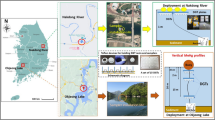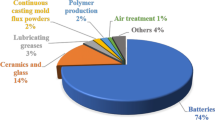Abstract
Thallium (Tl) is a typical toxic element, whose biological effects and geochemical behavior are closely related with its chemical speciation in the environment. In this context, the objective of the present study was to develope an effective method for separation of Tl (I) and Tl (III) based on solid-phase extraction (SPE) using anion exchange resin AG1-X8 as a sorbent and ICP-MS measurement. In this proposed method, Tl (I) and Tl (III) could be separated by selective adsorption of Tl (III)-DTPA in the resin, while Tl (III) was eluted by the solution mixed with HCl and SO2. The validity of this method was confirmed by assays of standard solutions of Tl (I) and Tl (III), as well as with spike of contaminated samples. The present study results revealed that higher concentration of Tl (I) (245.48 μg/l) and Tl (III) (20.92 μg/l) had been found near the acid mine drainage (AMD) sample of sediment pore water. The results revealed that Tl (I) of 61.47 μg/l and Tl (III) of 9.73 μg/l were present in the river water contaminated by acid mine drainage. This thallium speciation analysis implied that the dominant Tl (I) species in the river water studied might be due to the weathering of sulfide mineral–bearing rocks, mining, and smelting activities in the studied area.


Similar content being viewed by others
References
Al-Najar H, Schulz R, Romheld V (2003) Plant availability of thallium in the rhizosphere of hyperaccumulator plants: a key factor for assessment of phytoextraction. J Plant Soil 249(1):97–105
Amin B, Ismail A, Arshad A, Yap CK, Kamarudin MS (2009) Anthropogenic impacts on heavy metal concentrations in the coastal sediments of Dumai, Indonesia. Environ Monit Assess 148:291–305
Bajza Z, Vrcek IV (2001) Water quality analysis of mixtures obtained from tannery waste effluents. Ecotoxicol Environ Saf 50(1):15–18
Baker RGA, Rehkamper M, Hinkley TK, Nielsen SG, Toutain JP (2009) Investigation of thallium fluxes from subaerial volcanism – implications for the present and past mass balance of thallium in the oceans. Geochim Cosmochim Acta 73:6340–6359
Batley GE, Florence TM (1975) Determination of thallium in natural waters by anodic stripping voltammetry. J Electroanal Chem Interfacial Electrochem 61:205–211
Biagioni CM, D’Orazio G, Lepore FD, Acapito S, Vezzoni (2017) Thallium-rich rust scales in drinkable water distribution systems: a case study from northern Tuscany, Italy. Sci Total Environ 588:491–501
Campanella BM, Onor A, D’Ulivo A, Giannecchini M, D’Orazio R, Petrini E, Bramanti E (2016) Human exposure to thallium through tap water: a study from Valdicastello Carducci and Pietrasanta (northern Tuscany, Italy). Sci Total Environ 548–549:33–42
Campanella B, Casiot C, Onor M, Perotti M, Petrini R, Bramanti E (2017) Thallium release from acid mine drainages: speciation in river and tap water from Valdicastello mining district (northwest Tuscany). Talanta 171:255–261
Casiot C, Egal M, Bruneel O, Verma N, Parmentier M, Elbaz-Poulichet FO (2011) Predominance of aqueous Tl(I) species in the river system downstream from the abandoned Carnoules mine (Southern France). J Environ Sci Technol 45:2056–2064
Cobelo-García AM, Filella P, Croot C, Frazzoli G, Du Laing N, Ospina-Alvarez S, Rauch P, Salaun J, Schäfer S (2015) Zimmermann COST action TD1407: network on technology-critical elements (NOTICE)-from environmental processes to human health threats. Environ Sci Pollut Res 22(19):15188–15194
Coetzee PP, Fischer JL, Hu M (2003) Simultaneous separation and determination of Tl (I) and Tl (III) by IC-ICP-OES and IC-ICP-MS. Water SA 29(1):17–22
Couture P, Fortin C, Hare L, Lapointe D, Pitre D (2011) A critical review of thallium in aquatic ecosystems. INRS, Centre Eau, Terre et Environnement
Das AKM, Dutta ML, Cervera M (2007) Determination of thallium in water samples. Microchem J 86(1):2–8
Dorazio M, Biagioni C, Dini A, Vezzoni S (2016) Thallium-rich pyrite ores from the Apuan Alps, Tuscany, Italy: constraints for their origin and environmental concerns. Mineral Deposita:1–21
Escudero LB, Wuilloud RG, Olsina RA (2013) Sensitive determination of thallium species in drinking and natural water by ionic liquid-assisted ion pairing liquid-liquid microextraction and inductively coupled plasma mass spectrometry. J Hazard Mater 244-245:380–386
Fergusson JE (1990) The heavy elements: chemistry, environmental impact and health effects. Pergamon Press, Oxford
Jia YL, Xiao TF, Zhou GZ, Ning ZP (2013) Thallium at the interface of soil and green cabbage (Brassica oleracea L. var. capitata L.): soil-plant transfer and influencing factors. Sci Total Environ 451:140–147
Jia Y, Xiao TF, Sun J, Yang F, Baveye PC (2018) Microcolumn-based speciation analysis of thallium in soil and green cabbage. Sci Total Environ 630:146–153
Kaplan DI, Mattigod SV (1998) Aqueous geochemistry of thallium. In: Nriagu JO (ed) Thallium in the environment. New York, Wiley, pp 15–29
Karbowska B, Zembrzuski W, Jakubowska M, Wojtkowiak T, Pasieczna A, Lukaszewski Z (2014) Translocation and mobility of thallium from zinc-lead ores. J Geochem Explor 143:127–135
Karlsson U, Düker A, Karlsson S (2006) Separation and quantification of Tl(I) and Tl (III) in freshwater samples. J Environ Sci Health A Tox Hazard Subst Environ Eng 41:1155–1167
Kersten M, Xiao TF, Kreissig K, Brett A, Coles BJ, Rehkämper M (2014) Tracing anthropogenic thallium in soil using stable isotopes. J Environ Sci Technol 48:9030–9036
Krasnodebska-Ostrega B, Asztemborska M, Golimowski J, Strusinska K (2008) Determination of thallium forms in plant extracts by anion exchange chromatography with inductively coupled plasma mass spectrometry detection (IC-ICP-MS). J Analyt Atomic Spectrom 23(12):1632–1635
Krasnodębska-Ostręga B, Pałdyna J, Wawrzyńska M, Stryjewska E (2011) Indirect anodic stripping voltammetric determination of Tl (I) and Tl (III) in the Baltic seawater samples enriched in thallium species. Electroanalysis 23:605–610
Krasnodȩbska-Ostrȩga B, Sadowska M, Piotrowska K, Wojda M (2013) Thallium (III) determination in the Baltic seawater samples by ICP MS after preconcentration on SGX C18 modified with DDTC. Talanta 112:73–79
Lan CH, Lin TS (2005) Acute toxicity of trivalent thallium compounds to Daphnia magna. Ecotoxicol Environ Saf 61:432.539
Li H, Li X, Long J, Li K, Chen Y, Jiang J et al (2019) Oxidation and removal of thallium and organics from wastewater using a zero-valent-iron-based Fenton-like technique. J Clean Prod 221:89–97
Lin TS, Nriagu JO (1999) Thallium speciation in the Great Lakes. J Environ Sci Technol 33(19):3394–3397
Lis J, Pasieczna A, Karbowska B, Zembrzuski W, Lukaszewski Z (2003) Thallium in soils and stream sediments of a Zn-Pb mining and smelting area. Environ Sci Technol 37:4569–4572
Meeravali NN, Jiang SJ (2008) Ultra-trace speciation analysis of thallium in environmental water samples by inductively coupled plasma mass spectrometry after a novel sequential mixed-micelle cloud point extraction. J Anal At Spectrom 23:555–560
Nielsen SG, Wasylenki LE, Rehkamper M, Peacock CL, Xue ZC, Moon EM (2013) Towards an understanding of thallium isotope fractionation during adsorption to manganese oxides. Geochim Et Cosmoch Acta 117:252–265
Nolan A, Schaumloffel D, Lombi E, Ouerdane L, Łobinski R, McLaughlin M (2004) Determination of Tl-(I) and Tl-(III) by IC-ICP-MS and application to Tl speciation analysis in the Tl hyperaccumulator plant Iberis intermedia. J Anal At Spectrom 19(6):757–761
Nowicka A, Krasnodębska-Ostręga B, Wrzosek B, Jastrzębska M, Sadowska M, Maćkiewicz M, Stojek Z (2014) Detection of oxidative damage of synthetic oligonucleotides caused by Tl (III) complexes. Electroanalysis 26:340–348
Ospina-Alvarez N, Burakiewicz P, Sadowska M, Krasnodebska-Ostrega B (2015) TlI and TlIII presence in suspended particulate matter: speciation analysis of thallium in wastewater. Environ Chem 12(3):374–379
Pavlickova J, Zbiral J, Smatanova M, Habarta P, Houserova P, Kuban V (2006) Uptake of thallium from artificially contaminated soils by kale (Brassica oleracea L. var. acephala). J Plant Soil Environ 52(12):544–549
Peacock CL, Moon EM (2012) Oxidative scavenging of thallium by birnessite: the explanation for thallium enrichment and stable isotope fractionation in marine ferromanganese precipitates. Geochim Cosmochim Acta 84:297–313
Petrini R, Cidu R, Slejko FF (2016) Thallium contamination in the Raibl mine site stream drainage system (eastern Alps, Italy). Mine Water Environ 35:55–63
Ralph L, Twiss MR (2002) Comparative toxicity of thallium(I), thallium (III), and cadmium (II) to the unicellular alga Chlorella isolated from Lake Erie. Bull Environ Contam Toxicol 68:261–268
Sadowska M, Biaduń E, Krasnodębska-Ostręga B (2016) Stability of Tl (III) in the context of speciation analysis of thallium in plants. Chemosphere 144:1216–1223
Scheckel KG, Hamon R, Jassogne L, Rivers M, Lombi E (2007) Synchrotron X-ray absorption-edge computed microtomography imaging of thallium compartmentalization in Iberis intermedia. J Plant Soil 290(1–2):51–60
Smith RM, Martell AE (1989) Stability constants 6. Plenum Press, New York
Stafilov T, Sajn R, Jasminka A (2013) Distribution of arsenic, antimony, and thallium in the soil in Kavadarci and its surroundings, Republic of Macedonia. Soil Sediment Contam 22:105–118
Twining BS, Twiss MR, Fisher NS (2003) Oxidation of thallium by freshwater plankton communities. Environ Sci Technol 37:2720–2726
Twiss MR, Twining BS, Fisher NS (2004) Bioconcentration of inorganic and organic thallium by freshwater phytoplankton. Environ Toxicol Chem 23:968–973
Vanek A, Chrastny V, Komarek M, Galuskova I, Drahota P, Grygar T et al (2010a) Thallium dynamics in contrasting light sandy soils-soil vulnerability assessment to anthropogenic contamination. J Hazard Mater 173:717–723
Vanek A, Komarek M, Chrastny V, Becka D, Mihaljevic M, Sebek O, Panuskova G, Schusterova Z (2010b) Thallium uptake by white mustard (Sinapis alba L.) grown on moderately contaminated soils--agro-environmental implications. J Hazard Mater 182(1–3):303–308
Voegelin A, Pfenninger N, Petrikis J, Majzlan J, Plötze M, Senn AC, Mangold S, Steininger R, Göttlicher J (2015) Thallium speciation and extractability in a thallium- and arsenic-rich soil developed from mineralized carbonate rock. Environ Sci Technol 49(9):5390–5398
Xiao TF, Guha J, Boyle D, Liu CQ, Zheng BS, Wilson G, Rouleau A, Chen J (2004) Naturally occurring thallium: a hidden geoenvironmental health hazard? Environ Int 30:501–507
Xiao TF, Yang F, Li SH, Zheng BS, Ning ZP (2012) Thallium pollution in China: a geoenvironmental perspective. Sci Total Environ 421:51–58
Xiao Q, Rasool A, Xiao TF, Baveye PC (2018) A modified method of separating Tl(I) and Tl (III) in aqueous samples using solid phase extraction. Chem Cent J 12:132
Xie WW, Tremaine PR (1999) Thermodynamics of aqueous diethylenetriamine pentaacetic acid (DTPA) systems: apparent and paetual molar heat capacities and volumes of aqueous H2DTPA3-, DTPA5-, CuDTPA3-, and Cu2DTPA from 10 to 55 °C. J Solut Chem 28:291–325
Xiong Y (2009) The aqueous geochemistry of thallium: speciation and solubility of thallium in low temperature systems. Environ Chem 6(5):441–451
Xu H, Luo Y, Wang P, Zhu J, Yang Z, Liu Z (2019) Removal of thallium in water/wastewater: a review. Water Res 165:114981
Acknowledgments
Constructive comments and helpful suggestions from the reviewers are acknowledged, which have helped improve this manuscript considerably.
Funding
This work was financially supported by the National Natural Science Foundation of China [grant numbers 41830753, U1612442, and 41673138].
Author information
Authors and Affiliations
Corresponding author
Ethics declarations
Conflict of interest
The authors declare that they have no conflict of interest.
Additional information
Responsible editor: Philippe Garrigues
Publisher’s note
Springer Nature remains neutral with regard to jurisdictional claims in published maps and institutional affiliations.
Rights and permissions
About this article
Cite this article
Rasool, A., Xiao, T., Ali, S. et al. Quantification of Tl (I) and Tl (III) based on microcolumn separation through ICP-MS in river sediment pore water. Environ Sci Pollut Res 27, 9686–9696 (2020). https://doi.org/10.1007/s11356-019-07553-1
Received:
Accepted:
Published:
Issue Date:
DOI: https://doi.org/10.1007/s11356-019-07553-1




